| Day 1 Beijing ( ) |
| Upon arrival at Beijing airport, you will be met by our English speaking tour guide and transferred to hotel. Leisure on your own for the rest of the day. |
| Beijing | As the center of politics, cultural and international exchange, Beijing is a modern metropolis full of vitality.
For the history buffs, Beijing is a living museum, but it has something to offer everyone. It is also the starting point for most of our China vacations. |
|
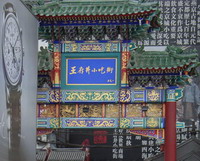 |
| [ Optional ] Wangfujing Streeet: It is the grandest shopping area in Beijing, congested with modern shopping malls, such as the Oriental Plaza, Wangfujing Department Store, etc. It is also home to a wealth of hotels and specialty shops. Around is an afflicted snack street where you can enjoy the most authentic Beijing snacks. |
|
| Day 2 Beijing ( B,L ) |
| Sightseeing day in Beijing, enjoy local culture show at night. |
| Tian An Men Square | As the largest city plaza in the world, it is of great cultural significance for its seeing of several key events in Chinese history. Today here are always sightseers and kite-flyers. Most visit at dawn or dusk to see the flag raising and lowering conducted by the PLA. | | Summer Palace | The Summer Palace deserves your visit to her exquisite buildings, long corridor, and beautiful bridges. Her shoreline pathway makes an excellent run or walk for you. It was a luxurious imperial garden for royal families to rest and entertain in Chinese Qing Dynasty. | | Forbidden City | For almost 500 years, the Forbidden City served as the home of 24 Emperors and their households, and the ceremonial and political center of the Chinese imperial government. It was listed by UNESCO as a World Cultural Heritage Site in 1987. |
|
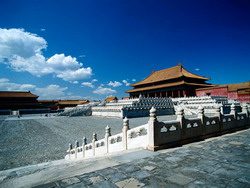 |
| [ Optional ] Kungfu show: The splendid Kung Fu show, running daily in Red Theater of Beijing shows you an authentic Kung Fu on the spot, which combining story-telling, acrobatics to celebrate the philosophy and skill of martial airs. You enjoy the opportunity to contact performers directly after the show or to learn Kung Fu from them! |
|
| Day 3 Beijing ( B,L ) |
| Visit the famous Great Wall and Ming Tombs. Highly recommend you to climb up the Wall by foot. You might also take cable car, the extra cost is RMB 50 one way. |
| Sacred Way | It was originally built to lead to Changling Tomb as a symbol of the passed emperor’s journey to heaven in their afterlife. Alongside the Sacred Road are 12 pairs of animal marble figures such as lions, elephants and 6 pairs human marbles such as generals and public officials. | | Ming Tombs (Changling) | Changling Tomb is the largest and the most well-preserved one of the 13 Ming Tombs. Emperor Zhu Di, the third emperor of Ming Dynasty, and his Empress are co-buried in this grave. The 32 giant pillars in the Ling’en Hall, Changling’s main building, remain as solid as before after over 500 years. | | Mutianyu Great Wall | Mutianyu Great Wall seems to be not popular as section at Badaling, but it doesn’t get as crowded, which assist you in appreciating the magnificent scenery easily. Woods cover over 96% of the total scenic area, and its 2.5 kilometer stretch allows you a walk with striking landscape and fresh air. |
|
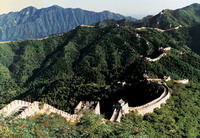 |
| [ Optional ] Peking Roast Duck: With its long history, Peking roast duck is well known among both domestic and overseas customers. The duck is hung in the oven and roasted by flame burning from fruit-wood. It takes about 45 minutes for the duck to be done. The finished duck is characteristic with crispy skin, tender meat and the fragrance from the fruit-wood. |
|
| Day 4 Beijing, Xian ( B,L ) |
| Transfer to Beijing airport for your flight to Xian. Pickup by our tour guide in Xian and start sightseeing tours today. |
| Great Mosque | The Great Mosque is one of the largest and best-kept Islamic mosques in China, which was originally built in 742 AD during the Chinese Tang Dynasty(618-907). It combined Islamic culture with Chinese traditional architecture seamlessly and became most featured and renowned mosques in China. | | Ancient City Wall | It is the most well-preserved ancient military defensive systems in the world. It is composed of the moat, hanging bridges, battlements, watchtowers, tunnels and parapet. Today, the roadway is a promenade enjoyed by strolling tourist. Cycling on the wall with families is a great thing! | | Shaanxi Provincial History Museum | It is one of the Top 3 national museums in China. This museum boasts 370,000 pieces relics range from prehistory when human just used simple stone tools to exquisite wares in the Qing Dynasty (1644–1911)., and enables you to see the vast changes of China in the past 5,000 years. |
|
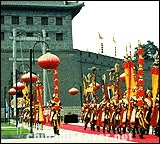 |
| [ Optional ] Muslim quarter: The Muslim Quarter features a mix of Chinese and Islamic cultures. It wins the reputation for the alley lined with market stall and the tasty snack food. Meanwhile, it is a good place to head for when looking for those hard-to-find souvenirs. |
|
| Day 5 Xian ( B,L ) |
| The highlight today is the visit of Terra-cotta Armies. |
| Xian Bell Tower | Built in 1384 A.D, the Bell Tower boasts a history of over 600 years. It is the largest and best-preserved of its kind in China. Visiting the Bell Tower, you can still see the Big Iron Bell which was made in Ming Dynasty, 2,500 kilograms in weight. | | Big Wild Goose Pagoda | It was built in 652 during the Tang Dynasty and currently boasts height of seven stories. It’s said that Master Xuan Zang built this pagoda to house the Buddhist scriptures and relics he had brought back from India. | | Terra Cotta Warriors and Horses Museum | Terracotta Warriors is the underworld terracotta army of Emperor Qin Shihuang (the first unifier of China, 259BC-210BC). It’s reputed as the Eighth Miracle of the World. Now the Terracotta Museum consists of Pit 1, Pit 2, Pit 3 and Pit 4 as well as the Hall of the two bronze chariots and horses. |
|
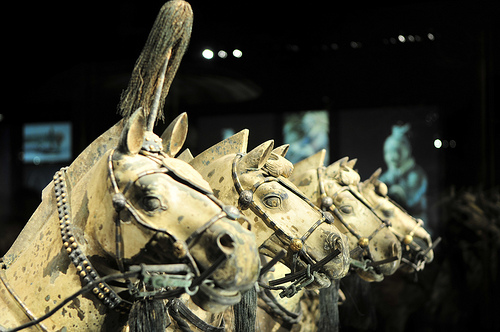 |
| [ Optional ] Tang Dynasty Dinner Show: The Tang Dynasty show has absorbed all the best music from the past dynasties and that of western regions and other countries. It vividly reflects their thriving economy, the friendly relationship between Tang and its neighboring countries, and the daily life of the Tang people. |
|